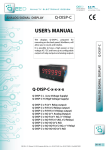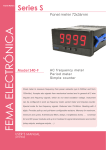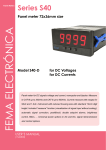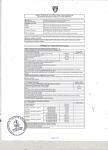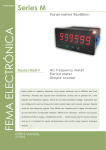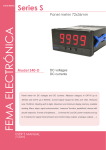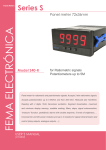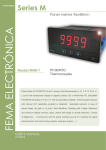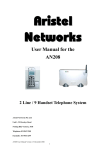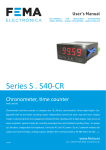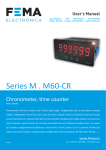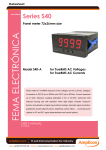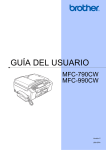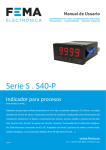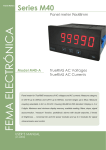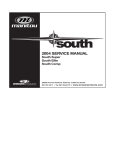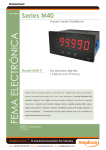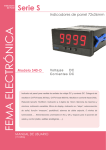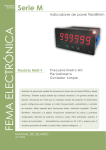Download FEMA ELECTRÓNICA
Transcript
Series S Panel Meters FEMA ELECTRÓNICA Panel meter 72x36mm Model S40-CR Ti m e c o u n te r C h ro n o me te r Panel meter 72x36mm with function time counter and chronometer. Fully configurable. Up and down counting modes. Reading in decimal and sexagesimal formats. Controls for ‘Start’, ‘Stop’ and ‘Reset’. Special working modes with second timer for accumulative time, exceeded time, cycle counter, display hold and memory of cycle duration (maximum and minimun duration of cycle). Controls by mechanical contact and configurable for TTL, NPN, push-pull, inductive, etc. Front and rear reset. Size 72x36 mm. 4 digits. Universal AC and DC power modules. Up to 2 modules for signal retransmission and control (relay outputs, analogue outputs, ...). USER’S Manual (3216r02) User’s Manual S40-CR 1. Meter S40-CR Panel meter 72x36mm chronometer Configurable chronometer and time counter. Selectable reading in 12 different formats, with hours, minutes, seconds and days, in decimal or sexagesimal (clock) format. Up and down counter. Preset value configurable. Controls Chronometer with 3 inputs ‘A’, ‘B’ and ‘R’ to control ‘Start’, ‘Stop’ and ‘Reset’ functions. Functions activated by mechanical contacts, on falling edge. Also configurable for push-pull, NPN, PNP, TTL, inductive, etc, by internal pull-up/pull-down resistors, trigger levels, excitation voltage and antirrebound filters. Activation also configurable for rising edge or levels. Alternative connection (‘con.2’) Using alternative connection (‘con.2’) signal level on input ‘A’ controls ‘Start / Stop’ function, signal level on input ‘R’ controls ‘Reset’ function, and signal level on input ‘B’ controls activation of special function (see ‘Special functions on input ‘B’’ further in this section). Memory The instrument retains last reading on memory in case of power loss. Memory of maximum and minimum reading are accessible from frontal keypad. function ‘B.2’ (cycles) - internal counter is activated, and its value increased by ‘+1’ each time the configured alarms get activated. To view the internal counter value, activate input ‘B’. Together with parameter ‘On_Alarm / Reset’, time cycles can created and counted. function ‘B.3’ (accumulated) - internal chronometer is activated, counting the total time that the instrument has been powered, the total time that the main chronometer has been stopped or the total time that the main chronometer has been counting (‘Start’). To view the internal chronometer value, activate input ‘B’. function ‘B.4’ (exceeded) - internal chronometer is activated, counting the time passed since the configured alarm got active. To view the internal chronometer value, activate input ‘B’. function ‘B.5’ (hold) - status of channel ‘B’ controls the display hold, while the main chronometer continues counting on the background. function ‘B.6’ (maximum and minimum cycle duration) signal ‘Reset’ updates the maximum and minimum memory values, for a repetitive cycle. Application to save maximum and minimum production times of a certain process. Reset Flashing Front and rear reset available. Front reset can be disabled. Rear reset configurable for activation on falling-edge, raisingedge, or level. Several configurations available to activate flash on display in case of stop, start or alarm activation. Alarms Instrument with up to 2 alarms that control 2 relay outputs (optional). Alarms configurable with ‘normal’ mode (alarm activates when setpoint is reached) and ‘repeat’ mode (alarm activates each time the setpoint time has passed). See section ‘1.5 Alarm modes’ for more information. Each alarm has a parameter ‘On_Alarm’ which allows to configure a stop, a reset, a jump to 0, or continue (nothing done) when alarm is reached. Using ‘On_Alarm’ configured to ‘reset’ allows to create cycles that can be counted with special function ‘B.2’. Special functions on input ‘B’ Special functions can be assigned to input ‘B’ : function ‘B.1’ (up / down control) - signal on input ‘B’ controls the chronometer counting direction. First start security Function ‘On power-up’ defines a delay time in case of power on, the default starting mode (‘Start’ or ‘Stop’) and optional reset activation. Configurable quick access The UP (5) keypad gives quick access to the functions selected by the user, such as alarm setpoints, preset value and memories of maximum and minimum. Control options Optional up to 2 relay outputs, and analog outputs with 4/20mA and 0/10Vdc. Mechanical Standard 72x36mm size. Universal AC and DC power options. IP54 front protection, with optional IP65. Optional with green led. Connections via plug-in screw terminals and configuration via three front push-buttons. For industrial applications. FEMA ELECTRÓNICA - Page 2 User’s Manual S40-CR Index 1. Meter S40-CR . . . . . . . . . . . . . . . . . . . . . 2 1.1 Order reference . . . . . . . . . . . . . . . . . . 3 1.2 Front view . . . . . . . . . . . . . . . . . . . . . 3 1.3 Rear view . . . . . . . . . . . . . . . . . . . . . 3 1.4 Control led . . . . . . . . . . . . . . . . . . . . . 4 1.5 Alarm modes . . . . . . . . . . . . . . . . . . . 4 1.6 Utility ‘Trigger Sense’ . . . . . . . . . . . . . . . 4 1.7 Connections . . . . . . . . . . . . . . . . . . . . 4 1.8 Input channel configuration . . . . . . . . . . . . 5 1.9 Power Connections . . . . . . . . . . . . . . . . 5 1.10 Operating the menus . . . . . . . . . . . . . . . 5 1.11 Technical data . . . . . . . . . . . . . . . . . . 6 1.11 Technical data (cont.) . . . . . . . . . . . . . . . 6 1.12 Mechanical dimensions (mm) . . . . . . . . . . 6 1.13 Configuration menu . . . . . . . . . . . . . . . 8 1.13.1 Menu Fn.b.1 - Control Up/Down . . . . . . . 10 1.13.2 Menu Fn.b.2 - Cycles . . . . . . . . . . . . 10 1.13.3 Menu Fn.b.3 - Accumulated . . . . . . . . . 10 1.13.4 Menu Fn.b.4 - Exceeded . . . . . . . . . . 10 1.13.5 Menu Fn.b.5 - ‘Hold’ . . . . . . . . . . . . . 10 1.13.6 Menu Fn.b.5 - ‘Max / Min’ . . . . . . . . . . 10 1.14 Configuration menu descriptions . . . . . . . . . 11 1.14.1 Function . . . . . . . . . . . . . . . . . . . . 11 1.14.2 Configuration . . . . . . . . . . . . . . . . . . 11 1.14.3 Input ‘B’ functions . . . . . . . . . . . . . . . . 11 1.14.4 Menu Sensor . . . . . . . . . . . . . . . . 12 1.14.5 Menu Alarms . . . . . . . . . . . . . . . . 12 1.14.6 Menu Tools . . . . . . . . . . . . . . . . . 13 1.14.7 Menu OptX - Options . . . . . . . . . . . . 13 1.15 Default factory configuration . . . . . . . . . . 13 1.16 Accessing the instrument . . . . . . . . . . . . 14 1.17 Messages and errors . . . . . . . . . . . . . . 14 1.18 Warranty . . . . . . . . . . . . . . . . . . . . 15 1.19 Installation precautions . . . . . . . . . . . . . 15 1.20 CE declaration of conformity . . . . . . . . . . 15 2. Output and control modules . . . . . . . . . . . . . 16 2.1 Module R1 . . . . . . . . . . . . . . . . . . . . 16 2.2 Module AO . . . . . . . . . . . . . . . . . . . . 16 2.3 Modules R2, R4 . . . . . . . . . . . . . . . . . 17 3. More options and accessories . . . . . . . . . . . . 18 3.1 Option G . . . . . . . . . . . . . . . . . . . . . 18 3.2 Option IP65 . . . . . . . . . . . . . . . . . . . 18 1.1 Order reference Model S40 - CR Power - H -H -L (85-265 Vac/dc) (11-60 Vdc and 24/48 Vac) Option1 - Option2 --- - -R1 (1 relay) -AO (Analogue output) - (empty) 1.2 Front view ---R1 (1 relay) -AO (Analogue output) - (empty) Option1 Control led Units Logo Button ‘UP’ Quick access --- - -65 (IP65) -G (green) -NBT(no buttons) - (empty) 1.3 Rear view Alarms Button ‘LE’ Front reset Others Button ‘SQ’ Access to ‘Configuration menu’ (press 1 sec.) 0 XAB R Controls FEMA ELECTRÓNICA - Page 3 Option2 890 Power User’s Manual S40-CR 1.4 Control led 1.7 Connections The ‘Control led’ (see section 1.2) flashes when the chronometer is counting (‘Start’). It remains off when the chronometer is stopped (‘Stop’). The ‘Control led’ function is to indicate when the chronometer is counting. The flashing rate is 1 second. By default, the control led is enabled in reading formats which include minutes, hours or days, and disabled in reading formats which include seconds, tenths of second or cents of second. Default connections (‘Con.1’) The chronometer has 3 input channels (terminals ‘A’, ‘B’ and ‘R’) to control ‘Start’, ‘Stop’ and ‘Reset’ functions. By default, activation is on falling-edge, connecting the input terminal to 0V. For other configurations (NPN, PNP, ...) see section 1.8. 5V 2K4 2K4 2K4 1.5 Alarm modes 0 XAB R The chronometer S40-CR has 2 configurable alarms (‘AL1’ and ‘AL2’). Each alarm controls a relay ‘R1’ (optional) and each alarm can be configured in three different modes : R - Reset B - Stop ‘oFF’ - Alarm disabled. Alarm performs no function. ‘Normal’ - Normal mode. Alarm activates when reading reaches the setpoint value. Configuration includes definition of setpoint value, alarm of maximum or minimum, configuration of delay for relay deactivation and a second optional setpoint to create windowed alarms. When alarm setpoint is reached, an action can be defined (‘stop’, ‘preset’, ‘reset to 0’ or ‘continue’) and a flashing control can be applied (see section ‘1.14.5 Alarms menu’ for more information). ‘Repeat’ - Repeat mode. Alarm activates each time the chronometer reaches a multiple of the setpoint. For example, with setpoint configured at 15:00 minutes, alarm will activate at 15.00, 30.00, 45.00, etc. Alarm remains active during the time configured on parameter ‘dEL.1’. After this time, alarm is deactivated. In down counting mode, with preset at 60:00 and setpoint at 20:00, alarm will activate at 40:00, 20:00 and 0:00. To stop chronometer at 0.00 configure Alarm2 in ‘Normal’ mode, configured as minimum alarm, with setpoint at 0.00 and function ‘On_Alarm / Stop’. In ‘Repeat’ mode only the following parameters apply : ‘SEt’ for setpoint value and ‘dEL.1’ for delay deactivation. Other parameters such as ‘Type’ (alarm of maximum or minimum), ‘Set2’ (second setpoint), ‘on.Al’ (function to apply on alarm activation) and ‘FL.AL’ (flash on alarm activation) do not affect. A - Start Vexc B R 0V Alternative connections (‘Con.2’) The alternative connections ‘Con.2’, is automatically selected when a special function is enabled (see section ‘1.14.3 Channel ‘B’ functions’). Working with the alternative connections ‘Con.2’, function ‘Start / Stop’ is controlled with input ‘A’. Input ‘A’ in low level (closed contact) activates ‘Start’ function. Input ‘B’ in high level (open contact) activates ‘Stop’ function. For other configurations (NPN, PNP, ...) see section 1.8. 5V 2K4 2K4 2K4 0 XAB R Note - repeat mode is not functional in formats which visualize tenths of second or cents of second. R - Reset B - Special function A - Start / Stop 1.6 Utility ‘Trigger Sense’ Vexc Visualizes the input state of channels ‘A’, ‘B’ and ‘R’, while adjusting the trigger level of the instrument (“<” / “SnSr” / “trIG”). Value is between 0 and 31 levels, where each level represents 0.12Vdc (a trigger value of 15 is fixed to 1.8Vdc). Channel A Channel B Channel R Channel B to ‘1’ A Trigger level Channel B to ‘0’ FEMA ELECTRÓNICA - Page 4 A B 0V R User’s Manual S40-CR 1.8 Input channel configuration 1.10 Operating the menus Inputs ‘A’, ‘B’ and ‘R’ are controlled (by default) with direct connections to 0V (free potential contact) and are activated by falling-edge (in default connection mode ‘Con.1’). Instrument has internal pull-up resistors enabled on each input and a 0V terminal to close the contact. For other configurations see the ‘Sensor’ section of the ‘Configuration Menu’ (‘<’ / SnSr). Configuration for inputs ‘A’ and ‘B’ Inputs ‘A’ and ‘B’ share the following configuration parameters : pull-up / pull-down resistors, trigger levels and activation by rising or falling edge (connection type ‘Con.1) or activation by high or low level (connection type ‘Con.2’). Configuration for input ‘R’ (rear reset) Channel ‘R’ controls the ‘Reset’ function and its configuration is independent from inputs ‘A’ and ‘B’. It has its own pull-up / pull-down resistor, trigger level fixed to 2.5V and activation by high or low signal (edge or level control is configurable at menu entry ‘<’ / Tools / r.rSt). Common controls Excitation voltage (available from 5V to 18V on terminal ‘X’) provides excitation for sensors up to 70mA. Antirrebound filters apply to inputs ‘A’, ‘B’ and ‘R’. All these parameters are available inside the ‘Configuration menu’ and allow to adapt the instrument to a wide variety of controls, such as NPN, PNP, push-pull, namur, mechanical contact, TTL, CMOS, pick-up, inductive, ... 1.9 Power Connections Earth connection - Although a terminal is offered for earth connection, the connection is optional. The instrument does not need this connection for correct functioning nor for compliance with the security regulations. Power “H” fuse 250mA time-lag Power “L” fuse 400mA time-lag ‘Configuration menu’ (key SQ) (<) ‘Quick access menu’ (key UP) (5) The ‘configuration menu’ allows to change the configuration of the instrument. Press keypad (<) during 1 second to enter this menu. Access to the ‘configuration menu’ can be protected enabling the ‘PASSWORD’ function. During operation with the ‘configuration menu’ the alarms are kept ‘on-hold’. While operating inside the ‘configuration menu’ the chronometer does not count. When leaving the ‘configuration menu’ the instrument restarts and applies the configuration indicated at menu entry ‘On Power Up’ (see section 1.14.2).On restart of the instrument, also the optional modules are restarted (relays, analogue outputs, ...). The ‘quick access menu’ is a configurable menu, accessible through key UP (5), where the user can configure access to the following information : memory values for maximum, minimum and cycles, setpoint values for alarms 1, 2 and 3 and preset value. The list of configurable parameters is accessible at “tooL” / “k.uP”. Alarm setpoints and preset value can be modified when enabled in the ‘quick access menu’. If only one parameter is configured to be accessed through the ‘quick access menu’, access to this parameter value is direct with only one touch on the UP (5). The ‘PASSWORD’ function does not block access to the ‘quick access menu’. While working inside the ‘quick access menu’ the instrument keeps working as normal in the background. There is no reset when leaving the ‘quick access menu’. Rollback - After 30 seconds without interaction from the operator, the instrument leaves the active menu and returns normal working mode. All changes are discarded. 8 9 0 Fuse - To comply with security regulation 61010-1, add to the power line a protection fuse acting as disconnection element, easily accessible to the operator and identified as a protection device. The instrument has two menus accessible to the user : ~ + ~ - Key SQ (<) - Selects the menu entry currently displayed. When entering a numeric value (for example a setpoint value) validates the value on display. Key UP (5) - Moves vertically on the menu entries. When entering a numeric value (for example a setpoint value) modifies the current digit by increasing its value up from 0 to 1, 2, 3, 4, 5, 6, 7, 8, 9. Key LE (3) - Leaves the current menu. Pressing LE several times will leave all menus. When leaving all menus in the configuration menu, changes will be saved . When entering a numeric value (for example a setpoint value) it moves from one digit to the next. Each digit value can then be modified with the UP button. FEMA ELECTRÓNICA - Page 5 User’s Manual S40-CR 1.11 Technical data Digits Type Color Height 1.11 Technical data (cont.) Mechanical Mounting panel Connections plug-in screw terminals Weight <150 grams Housing materials ABS, polycarbonate Reading formats Front size 72x36mm *Nomenclature (d=days, h=hours, m=minutes, s=seconds, c=cents of sec.) Panel cut-out 69x32.5mm Deep from panel 98mm (includes terminal) 4 7 segments red or green 14 mm Sexagesimal reading formats dd.hh hh.mm mm.ss Protection IP54 standard IP65 optional (Front filter sealed. Opening the front filter breaks the seal) Decimal reading formats ssss mmmm hhhh sss.s mmm.m hhh.h ss.ss mm.mm hh.hh Maximum reading Minimum reading 99.59 / 99.23 / 9999 -19.59 / -19.23 / -1999 Accuracy Of the quartz oscillator ±0.01% Thermal drift 20ppm/ºC Controls Default signal Configurable for ... Maximum Vdc at input Vexc configurable Refresh Display refresh Power Power “H” Power “L” Consumption Isolation 1.12 Mechanical dimensions (mm) 36 Start, Stop, Reset Free potential contact push-pull, NPN, PNP, Pick-up, TTL, inductive, mechanical, ... ±30Vdc 5V, 9V, 15V, 18V (max 70mA) 72 32,5 Panel cut-out 69 12 / second (tested 60 seconds) 85 to 265 Vac/dc 11 to 60 Vdc and 24/48Vac <4W 3500Veff for power “H” 2000Veff for power “L” Configuration 3 frontal push buttons Functions available Preset Count direction Memory of counter Reset configurable Temperature Operation 0 to 50ºC Temperature Storage –20 to +70ºC Warm-up 15 minutes Functions ‘On_Alarm’ Zeros to the left Password Brightness control yes, configurable up / down yes, recovers data on power loss yes, front and/or rear reset and/or assigned to setpoint yes, configurable yes, configurable yes, configurable yes, 5 levels Optional boards maximum 2 (see section 2) FEMA ELECTRÓNICA - Page 6 18 80 8 T H IS P A G E B L A N K User’s Manual S40-CR FEMA ELECTRÓNICA - Page 7 User’s Manual S40-CR 1.13 Configuration menu Press ‘SQ’ button (<) during 1 second to enter ‘Configuration Menu’ Explanation on each menu entry starts at section 1.14 Flash 0.00 a 99.59 Function View formats Flash on Stop 0.00 a 99.59 0.00 a 99.23 Flash on Start 0 a 9999 Input ‘B’ function selection 0.0 a 999.9 0.00 a 99.99 Function assigned to input ‘B’. It activates connection type ‘Con.2’ (see section 1.5) 0 a 9999 0.0 a 999.9 0.00 a 99.99 0 a 9999 0.0 a 999.9 0.00 a 99.99 input ‘B’ function configuration Up counter Counting direction Menu varies depending on the ‘B’ function selected. See section 1.13.1 to see all menus. This entry shows “Fn.b.n” if ‘function b’ is not selected. Down counter No pulls Preset value -1999 a 9999 Preset Sensor Pulls for inputs ‘A’ and ‘B’ Pull Up Pull Down On rising edge Configuration Front reset Activation for inputs ‘A’ and ‘B’ On falling edge No pulls On Power-Up Delay Seconds Pulls for reset Pull Down Reset State Pull Up Activation for reset Trigger FEMA ELECTRÓNICA - Page 8 On rising edge On falling edge Trigger level from 0 to 31. Each level represents 0.12V. Vertical leds to the left represent the state of channels ‘A’, ‘B’ and ‘R’. See section 1.6 for ‘Trigger Sense’ utility. User’s Manual S40-CR 1.13 Configuration menu (cont.) Excitation voltage 5, 9 ,15 ,18Vdc Excitation voltage Tools Key UP Setpoint1 Setpoint2 Antirrebound filter (0 a 1000 mSec.) Antirrebound See Max. See Min Alarmas Cycles Deactivated Alarm1 Alarm mode Preset Normal Repeat By edge Al. as maximum Alarm type Rear reset Al. as minimum By level With left zeros Left Zeros Setpoint Without left zeros Setpoint Delay1 Password Delay on relay deactivation (in seconds) Factory configuration Setpoint2 Password 4 digits Apply Second setpoint Firmware version Continue On alarm Version Minimum To zero Brightness To preset Maximum Stop Menu for optional module at ‘Opt1’ Alarm Flash Opción1 Menu for optional module at ‘Opt2’ Opción2 Menu for Alarm2 FEMA ELECTRÓNICA - Page 9 User’s Manual S40-CR 1.13.1 Menu Fn.b.1 - Control Up/Down Function B.1 Control up/down This function does not have configurable parameters 1.13.4 Menu Fn.b.4 - Exceeded Function B.4 Exceeded Format 1.13.2 Menu Fn.b.2 - Cycles Function B.2 Cycles on AL1 Start on AL2 on Reset 1.13.5 Menu Fn.b.5 - ‘Hold’ Function B.5 Hold 1.13.3 Menu Fn.b.3 - Accumulated Función B.3 Acumulado Format This function does not have configurable parameters 1.13.6 Menu Fn.b.6 - ‘Max / Min’ Function B.6 Max / Min This function does not have configurable parameters Count FEMA ELECTRÓNICA - Page 10 User’s Manual S40-CR 1.14 Configuration menu descriptions Function ‘B’ (‘Fn.b’) - Selects and activates the ‘B’ function. 1.14.1 Function Reading formats (‘View’) - Select the reading format for the chronometer. Nomenclature for the reading formats indicated below is : d=days, h=hours, M=minutes, S=seconds, c=cents. (To the right, minimum value in the negative range). ‘hh.MM’ ‘MM.SS’ ‘dd.hh’ from 0.00 to 99.59 from 0.00 to 99.59 from 0.00 to 99.23 (-19.59) (-19.59) (-19.23) ‘SSSS’ ‘SSS.S’ ‘SS.SS’ from 0 to 9999 seconds from 0 to 999.9 seconds from 0 to 99.99 seconds (-1999) (-199.9) (-19.99) ‘MMMM’ ‘MMM.M’ ‘MM.MM’ from 0 to 9999 minutes from 0 to 999.9 minutes from 0 to 99.99 minutes (-1999) (-199.9) (-19.99) ‘hhhh’ ‘hhh.h’ ‘hh.hh’ from 0 to 9999 hours from 0 to 999.9 hours from 0 to 99.99 hours (-1999) (-199.9) (-19.99) Direction (‘dIr’) - Value ‘uP’ / ‘doWn’. Select ‘uP’ to count time in ascending mode or ‘doWn’ for descending mode. On down mode, when reaching 0, instrument can be configured to stop or to continue in the negative range. Preset (‘PrSt’) - Select the preset value. The preset value loads on display when reset function is activated. 1.14.2 Configuration Front reset (‘F.rSt’) - Value ‘on’ / ‘oFF’. Select ‘on’ to activate the reset function when front key ‘LE’ (3) is pressed. Select ‘oFF’ to deactivate the front reset (pressing the ‘LE’ key will perform no action). On power-up (‘on.Pu’) - Actions to apply when instrument restarts (at power up and when leaving ‘configuration menu’). The start up sequence is as follows : instrument starts in ‘Stop’ mode, applies the delay indicated in the ‘dLAy’ parameter, applies a reset as indicated in the ‘rSt’ parameter, applies ‘Start’ or ‘Stop’ as indicated in the ‘StAt’ parameter, then senses inputs ‘A’, ‘B’ and ‘R’. Delay (‘dLAy’) - Value from 1 to 99 seconds. This delay is applied to the start-up sequence of the instrument. Configure ‘B’ function - Configuration parameters for the ‘B’ function selected (see section 1.14.3). 1.14.3 Input ‘B’ functions Note - input ‘B’ functions activate connections mode ‘Con.2’ (see section 1.7). Function b.1 (‘fn.b.1’) - Controls up / down chronometer. Without configuration parameters. Input ‘B’ in high level (‘1’) activates up counting. Input ‘B’ in low level (‘0’) activates down counting. Function b.2 (‘fn.b.2’) - Cycle counter. Enables internal counter called ‘cycle counter’ (from 0 to 9999). The ‘cycle counter’ is read on display by activating input ‘B’. Events that add ‘+1’ to the ‘cycle counter’ are: Alarm1 (‘o.AL1’) - Value ‘on’ / ‘oFF’. Select ‘on’ to add ‘+1’ to the cycle counter each time ‘alarm1’ activates. Alarm2 (‘o.AL2’) - Value ‘on’ / ‘oFF’. Select ‘on’ to add ‘+1’ to the cycle counter each time ‘alarm2’ activates. Reset (‘o.rSt’) - Value ‘on’ / ‘oFF’. Select ‘on’ to add ‘+1’ to the ‘cycle counter’ each time the reset function activates (front reset, rear reset or alarm reset). Function b.3 (‘fn.b.3’) - Accumulated time. Enables an internal chronometer called ‘accumulated time’. The reading format is (by default) the same as the main chronometer, and is also configurable to ‘hh.mm’ or ‘mm.ss’ or ‘dd.hh’. Accumulated time is read on display by activating input ‘B’. The ‘accumulated time’ chronometer can be configured to count the total time the instrument has been working, the total time the instrument has been counting, or the total time the instrument has been stopped. Format (‘Form’) - Value ‘ch.A’, ‘hh.mm’ / ‘mm.ss’ / ‘dd.hh’. Reading format for the accumulated time. Count (‘cnt’) - Value ‘ALWS’ / ‘Strt’ / ‘StoP’. Select ‘ALWS’ to count when instrument is powered. Select ‘Strt’ to count when main chronometer is counting (‘Start’). Select ‘StoP’ to count when main chronometer is stopped (‘StoP’). To reset the ‘accumulated time’ chronometer, show the value on display and press reset (front or rear). Reset (‘rSt’) - Value ‘on’ / ‘oFF’. Select ‘on’ to load preset value on instrument start-up. State (‘StAt’) - Value ‘Strt’ / ‘StoP’. Applies a ‘Start’ or ‘Stop’ function to the start-up sequence. Flash (‘FLSh’) - Activates the flashing mode on display when chronometer is on ‘Stop’ and/or ‘Start’ mode. Flash on stop (‘StP.F’) - Value ‘on’ / ‘oFF’. Configures flashing display when chronometer is stopped. Flash on start (‘Str.F’) - Value ‘on’ / ‘oFF’. Configures flashing display when chronometer is counting. FEMA ELECTRÓNICA - Page 11 User’s Manual S40-CR 1.14 Descripción de los menús de configuración (cont.) Function b.4 (‘fn.b.4’) - Exceeded time. Enables an internal chronometer called ‘exceeded time’ chronometer. The reading format is (by default) the same as the main chronometer, and is also configurable to ‘hh.mm’ or ‘mm.ss’ or ‘dd.hh’. Exceeded time is read on display by activating input ‘B’. The ‘exceeded time’ chronometer is configured to start counting when the configured alarm is activated. Format (‘Form’) - Value ‘ch.A’, ‘hh.mm’ / ‘mm.ss’ / ‘dd. hh.mm’. Reading format for the exceeded time. Start (‘Strt’) - Value ‘o.AL1’ / ‘o.AL2’. Select the alarm event that will force the ‘exceeded time’ chronometer to start counting. To reset the ‘exceeded time’ chronometer, show the value on display and press reset (front or rear). This reset leaves the ‘exceeded time’ chronometer with 0 value and in ‘Stop’ mode. Function b.5 (‘fn.b.5’) - Main chronometer with display ‘hold’. Activate input ‘B’ to hold the reading of the chronometer. Chronometer still works on background. Deactivate input ‘B’ to recover the actual reading value of the chronometer. Function b.6 (‘fn.b.6’) - Time counter with function to save memory of maximum and minimum durations of a cycle. Signal ‘Reset’ updates the max and min memories. Signal ‘B’ applies a reset to both memories. For applications to measure production times, and save a record of the maximum and minimum duration of a production cycle. 1.14.4 Menu Sensor Configures the instrument to adapt to the sensors connected to inputs ‘A’, ‘B’ and ‘R’. Pulls on channels ‘A’ and ‘B’ (‘PuL.S’) - Value ‘no’, ‘P.uP’ or ‘P.dn’. Select ‘P.uP’ to activate the pull-up resistor on inputs ‘A’ and ‘B’. Select ‘P.dn’ to activate the pull-down resistor on inputs ‘A’ and ‘B’. Select ‘no’ to deactivate pulls on inputs ‘A’ and ‘B’. Trigger is automatically set to 2,5V (trigger level 20) when ‘P.uP’ or ‘P.dn’ are selected. Pull on reset (‘PuL.r’) - Value ‘no’, ‘P.uP’ or ‘P.dn’. Select ‘P.uP’ to activate the pull-up resistor on input ‘R’. Select ‘P.dn’ to activate the pull-down resistor. Select ‘no’ to deactivate pulls on input ‘R’. Trigger level for channel ‘R’ is fixed to 2.5V. Trigger (‘trIG’) - Value from 0 to 31 (0 to 3.9Vdc). Select trigger level, shared for inputs ‘A’ and ‘B’. Each level represents 0.128 Vdc. Trigger level for input ‘R’ is fixed at value to 2,5V. See section 1.6 for description on utility ‘Trigger Sense’. Activation for inputs ‘A’ and ‘B’ (‘Act.S’) - Value ‘on_h’ / ‘on_0’. Select ‘on_h’ to activate signals ‘A’ and ‘B’ on rising edge (mode ‘Con.1) or high level (mode ‘Con.2’). Select ‘on_0’ to activate signals ‘A’ and ‘B’ on falling edge (mode ‘Con.1’) or low level (mode ‘Con.2’). Activation for reset (‘Act.r’) - Value ‘on_h’ / ‘on_0’. Select ‘on_h’ to activate input ‘R’ on rising edge (or high level). Select ‘on_0’ to activate input ‘R’ on falling edge (or low level). Front reset is always controlled by state (pressed / not pressed). Rear reset can be controlled by state or by edge, configu- rable on menu entry ‘Tools / r.rSt’. By default rear reset is controlled by edge. Excitation voltage (‘V.Exc’) - Select value for excitation voltage between 5V, 9V, 15V and 18V. Select ‘no’ to disable excitation voltage. Antirrebound filter (‘rbnd’) - Value from 0 to 1000 mSec. For mechanical contact controls set value at 100mSeconds. When an impulse is received, the filter activates and no new impulses are counted for the duration of the filter value. When the filter time is over, next impulse received is counted and filter activates again. Affects to inputs ‘A’, ‘B’ and ‘R’. 1.14.5 Menu Alarms Configuration menu for 2 alarms on the chronometer. Each alarm can control a relay R1 (see section 2.1) optional and installable at slots ‘Opt1’ and ‘Opt2’. (Special module R4 allows for up to 4 simple relay outputs. See section 2.3 for more information). Alarm mode (‘Mode’) - Value ‘oFF’ / ‘norM’ / ‘rEPt’. Select ‘oFF’ to deactivate this alarm. Select ‘norM’ for ‘normal’ mode. Select ‘rEPt’ for ‘repeat’ mode’. See section ‘1.5 Alarm modes’ for more information on each mode. Type (‘tYPE’) - Value ‘MAX’ / ‘MIn’. Defines the behavior of the alarm as maximum or minimum alarm. The alarms configured as maximum are activated when the display value is equal or higher than the setpoint. The alarms configured as maximum are deactivated when the display is lower than the setpoint. The alarms configured as minimum have the inverse behavior. Setpoint (‘SEt’) - Alarm setpoint. Delay 1 (‘dEL.1’) - Value from ‘0.0’ to ‘99.9’ seconds. Deactivation delay for the alarm. Relay and front led are deactivated X seconds after alarm deactivation. Setpoint2 (‘SEt2’) - Second setpoint. The second setpoint allows for the creation of activation windows. If the alarm is configured as maximum with setpoint 15.00 and setpoint2 at 45.00, the alarm will be activated between 15.00 and 45.00 and deactivated when display is <15.00 and >45.00. On Alarm (‘on.AL’) - Value ‘cont’,’to.0’, ‘to.p’, ‘stop’. Behavior when setpoint is reached. Select ‘cont’ to continue counting Select ‘to.0’ to do a reset to ‘0’ and continue counting. Parameter ‘dEL.1’ (Deactivation delay) automatically configures to 1 second. Select ‘to.p’ to load preset value and continue counting. Parameter ‘dEL.1’ (Deactivation delay) automatically configures to 1 second. Select ‘stop’ to stop counting. Alarm Flash (‘AL.FL’) - Value ‘on’ / ‘oFF’. Select ‘on’ to activate flash when alarm is activated. Flash remains active until next interaction with the instrument (keypad is pressed or any change on inputs ‘A’, ‘B’ or ‘R’). FEMA ELECTRÓNICA - Page 12 User’s Manual S40-CR 1.14.6 Menu Tools 1.15 Default factory configuration Configuration of non usual parameters and special tools. Key UP (‘K.uP’) - Configuration of the information accessible with key UP (5). Select ‘on’ to activate desired entries. Pressing key UP (while in normal working mode), will visualize each one of the parameters selected. ‘ALr1’ - Alarm1 setpoint. Value can be modified. ‘ALr2’ - Alarm2 setpoint. Value can be modified. ‘MAX’ - Visualization of memory of maximum. Press UP (5) while the value is on display gives access to the function ‘RSt’. Press SQ (<) while ‘RSr’ will reset the memory of maximum. ‘MIn’ - Visualization of memory of minimum. Press UP (5) while the value is on display gives access to the function ‘RSt’. Press SQ (<) while ‘RSr’ will reset the memory of minimum. ‘cYcL’ - Total cycles, at special function Fn.b.2 ‘PrSt’ - Preset value. Value can be modified. Reset is activated when Preset is changed (reading jumps to preset value) Rear reset (‘r.rSt’) - Value ‘EdgE’ / ‘LEVL’. Select ‘EdgE’ to control rear reset by edges. Select ‘LEVL’ to control rear reset by levels. Left Zero (‘LZEr’) - Value ‘on’ / ‘oFF’. Select ‘on’ to visualize left zeros. Password (‘PASS’) - Select a 4 digit number to act as password. This password will be requested when entering the ‘Configuration Menu’ (key SQ <). To deactivate the password select ‘oFF’. Factory configuration (‘FAct’) - Factory default configuration. Select ‘yES’ to activate the factory default configuration. Version (‘VEr’) - Firmware version installed.. Light (‘LIGh’) - Brightness. Select between 5 predefined levels of brightness. 1.14.7 Menu OptX - Options Menu entries ‘oPt1’ and ‘oPt2’ give access to the configuration menus for the optional modules installed on slots ‘Opt1’, and ‘Opt2’. This menu depends on the installed option. If there is no option installed the instrument shows “nonE”. Relay modules ‘R1’ are controlled from the standard alarm menu (see section 1.14.5). Function (‘Func’) Reading format (‘View’) Direction (‘dIr’) Preset (‘PrSt’) Configuration (‘conF’) Front reset (‘F.rSt’) On Power-Up (‘on.Pu’) Delay (‘dLAY’) Reset (‘rSt’) State (‘StAt’) Flash (‘FLSH’) Flash on Stop Flash on Start Input ‘B’ function (‘Fn.b’) MM.SS ‘uP’ 00.00 ‘on’ (enabled) 0 ‘oFF’ ‘StoP’ ‘oFF’ ‘oFF’ ‘no’ (disabled) Sensor (‘SnSr’) Pulls on ‘A’ and ‘B’ (‘PuL.S’) ‘P.uP’ (pull-up) Pull on ‘R’ (‘PuL.r’) ‘P.uP’ (pull-up) Trigger (‘trIG’) 20 (2,5Vdc) Activation for ‘A’ and ‘B’ (‘Act.S’)‘on_0’ (falling edge) Activation for ‘R’ (‘Act.r’) ‘on_0’ (falling edge) Excitation voltage(‘V.EXc’) 15Vdc Antirrebound filter (‘rbnd’) 0 mSec. Alarms 1 and 2 Mode (‘ModE’) Type Setpoint Deactivation delay Setpoint 2 On Alarm Alarm Flash ‘oFF’ (disabled) maximum alarm 0 1.0 seconds Off continue ‘oFF’ Tools (‘TooL’) Key UP (‘K.UP’) Setpoint on alarm1 Setpoint on alarm2 Maximum Minimum Cycle Preset Rear reset Left zeros Password Brightness Off Off Off Off Off Off by edges Off Off 3 FEMA ELECTRÓNICA - Page 13 User’s Manual S40-CR 1.17 Messages and errors 1.16 Accessing the instrument You may need to access the inside of the instrument to insert additional modules. Use a flat screwdriver to unlock the upper clips marked with “A”. Then unlock the lower clips marked with “B” and remove the front cover. Let the inside of the instrument slide out of the housing. To reinsert the instrument make sure that all modules are correctly connected to the pins on the display module. Place all the set into the housing, assuring that the modules correctly fit into the internal guiding slides of the housing. Once introduced, place again the front cover by clipping first the upper clips “A” and then the lower clips “B”. The instrument can display the following messages and errors. “Err.1” Password entered is not correct. “Err.2” The instrument has detected an installed option but was unable to communicate. “Err.8” The instrument is limiting the current at Vexc. “9999” + flash. The display is in overrange (real display should be higher than 9999 and can not be displayed). “-1999” + flash. The display is in underrange (real display should be lower than -1999 and can not be displayed). “E.101” Option is installed but the type can not be recognized. Important - If your instrument was delivered with the IP65 front seal option, accessing the inside of the instrument will permanently break the IP65 seal on the areas of clips “A” and “B”. A B Risk of electric shock. Removing the front cover will grant access to the internal circuits. Disconnect the input signal to prevent electric shock to the operator. Operation must be performed by qualified personnel only. FEMA ELECTRÓNICA - Page 14 User’s Manual S40-CR 1.18 Warranty 1.20 CE declaration of conformity All instruments are warranted against all manufacturing defects for a period of 24 MONTHS from the shipment date. This warranty does not apply in case of misuse, accident or manipulation by non-authorized personnel. In case of malfunction get in contact with your local provider to arrange for repair. Within the warranty period and after examination by the manufacturer, the unit will be repaired or substituted when found to be defective. The scope of this warranty is limited to the repair cost of the instrument, not being the manufacturer eligible for responsibility on additional damages or costs. . 1.19 Installation precautions Risk of electrical shock. Instrument terminals can be connected to dangerous voltage. Instrument protected with double isolation. No earth connection required. Instrument is in conformity with CE rules and regulations. See “CE Declaration of Conformity” further in this document. This instrument has been designed and verified according to the 61010-1 CE security regulation, and is designed for applications on industrial environments. See the “CE Declaration of Conformity” further in this document for information on the category of measure and the degree of pollution levels that apply. Installation of this instrument must be performed by qualified personnel only. This manual contains the appropriate information for the installation. Using the instrument in ways not specified by the manufacturer may lead to a reduction on the specified protection level. Disconnect the instrument from power before starting any maintenance and / or installation action. The instrument does not have a general switch and will start operation as soon as power is connected. The instrument does not have protection fuse, the fuse must be added during installation. Manufacturer FEMA ELECTRÓNICA, S.A. Altimira 14 - Pol. Ind. Santiga E08210 - Barberà del Vallès BARCELONA - SPAIN www.fema.es - [email protected] Products - S40-CR The manufacturer declares that the instruments indicated comply with the directives and rules indicated below. Directive of electromagnetic compatibility 2004/108/CEE Directive of low voltage 73/23/CEE Security rules 61010-1 Equipment “Fixed” “Permanently connected” Pollution degree 1 and 2 (without condensation) Isolation Double Emission rules 61000-6-4 Immunity rules 61000-6-2 61000-4-2 Generic rules of emission Generic rules of immunity By contact ±4KV - Criteria B On air ±8KV - Criteria B 61000-4-3 61000-4-4 Criteria A On AC power lines: ±2KV - Criteria B On DC power lines: ±2KV - Criteria B On signal lines : ±1KV - Criteria B 61000-4-5 Between AC power lines ±1KV - Criteria B Between DC power lines ±0.5KV - Criteria B 61000-4-6 61000-4-8 61000-4-11 Criteria A 30A/m at 50Hz - Criteria A 0% 1 cycle Criteria A 40% 10 cycle Criteria B 70% 25 cycle Criteria B 0% 250 cycle Criteria B Barberà del Vallès October 2013 Daniel Juncà - Quality Manager The instrument is designed to be panel mounted. An appropriate ventilation of the instrument must be assured. Do not expose the instrument to excess of humidity. Maintain clean by using a humid rag and do NOT use abrasive products such as alcohols, solvents, etc. General recommendations for electrical installations apply, and for proper functionality we recommend : if possible, install the instrument far from electrical noise or magnetic field generators such as power relays, electrical motors, speed variators, ... If possible, do not install along the same conduits power cables (power, motor controllers, electrovalves, ...) together with signal and/or control cables. Before proceeding to the power connection, verify that the voltage level available matches the power levels indicated in the label on the instrument. In case of fire, disconnect the instrument from the power line, fire alarm according to local rules, disconnect the air conditioning, attack fire with carbonic snow, never with water. FEMA ELECTRÓNICA - Page 15 User’s Manual S40-CR 2. Output and control modules 2.1 Module R1 2.2 Module AO Module with 1 relay. Up to a maximum of two R1 modules can be installed in one S Series panel meter. For more relay output needs, check special modules R2 and R4. For more information see document 2657_S40_OPTIONAL_MODULES at www.fema.es Module with 1 analogue output. Configurable 4/20mA or 0/10Vdc. Output signal proportional to the reading. Scaling through the frontal keypad. Up to a maximum of two AO modules can be installed in one S Series panel meter. For more information see document 2657_S40_OPTIONAL_ MODULES at www.fema.es Relay type Maximum current Voltage Installable at Output Accuracy Isolated Thermal drift Installable at 3 contacts (Common, NC, NO) 8A (resistive load) 250 Vac continuously Option1 and/or Option2 Opt 1 A B Opt 1 Opt 2 C Signal Terminal A Terminal B Terminal C A B 4/20mA, 0/10Vdc selectable 0.1% FS yes, 1000Vdc 50 ppm/ºC for Vdc 60 ppm/ºC for mA Option1 and/or Option2 C MV A Power Signal Common NO - Normally Open NC - Normally Closed B Opt 2 C MV A B C Power Jumper M Jumper V mode mA mode Vdc Terminal A Terminal B Terminal C Vexc (+13.8Vdc @25mA) Signal output (mA or Vdc) GND FEMA ELECTRÓNICA - Page 16 User’s Manual S40-CR 2.3 Modules R2, R4 Special modules with 2 and 4 relays. Use special modules R2 or R4 when standard R1 modules do not provide required functionality for your application. Only one special module R2 or R4 can be installed in an S Series panel meter. Special modules R2 and R4 are not compatible with R1 modules. Configuration is done through the OPTx entry of the configuration menu. Functionality for R2 and R4 modules differs from standard R1 modules. For more information see document 2657_S40_OPTIONAL_MODULES at www.fema.es R4 R2 Opt 1 ABCDEF Signal Number of relays 2, or 4 Relay type 3 contacts (Common, NO, NC) Maximum current 6A (resistive load) (each relay) Voltage* 250 Vac continuously Installable at slot Opt.1. R2 fills OPT1 R4 fills OPT1 and OPT2 Terminal Plug-in screw terminals pitch 3.81mm * Terminals approved for 300V (according to UL1059, groups B and D) and 160V (according to VDE in CAT-III and pollution degree 3). Opt 2 G H I J K L Power Terminal A Terminal B Terminal C Terminal D Terminal E Terminal F Relay1 Common Relay1 NO - Normally Open Relay1 NC - Normally Closed Relay2 Common Relay2 NO - Normally Open Relay2 NC - Normally Closed Terminal G Terminal H Terminal I Terminal J Terminal K Terminal L Relay3 Común Relay3 NO - Normally Open Relay3 NC - Normally Closed Relay4 Common Relay4 NO - Normally Open Relay4 NC - Normally Closed FEMA ELECTRÓNICA - Page 17 User’s Manual S40-CR 3. More options and accessories 3.1 Option G Green led option. Green led 3.2 Option IP65 This option provides M series panel meters with IP65 front protection. The instrument is provided with the front cover sealed. Important - Removing the front cover to access the inside of the instrument will permanently disable the IP65 protection (see section 1.18). FEMA ELECTRÓNICA - Page 18 T H IS P A G E B L A N K User’s Manual S40-CR FEMA ELECTRÓNICA - Page 19 other products Panel Meters Standard 96x48mm Panel Meters Small 72x36mm Panel Meters Miniature 48x24mm Large Displays 60&100mm digit Signal Converters & Isolators Bar Meters www.fema.es ELECTRONIC INSTRUMENTATION FOR INDUSTRY FEMA ELECTRÓNICA, S.A. Altimira 14 - Pol. Ind. Santiga E08210 Barberà del Vallès BARCELONA - SPAIN Tel. (+34) 93.729.6004- www.fema.es Fax (+34) 93.729.6003- [email protected]




















